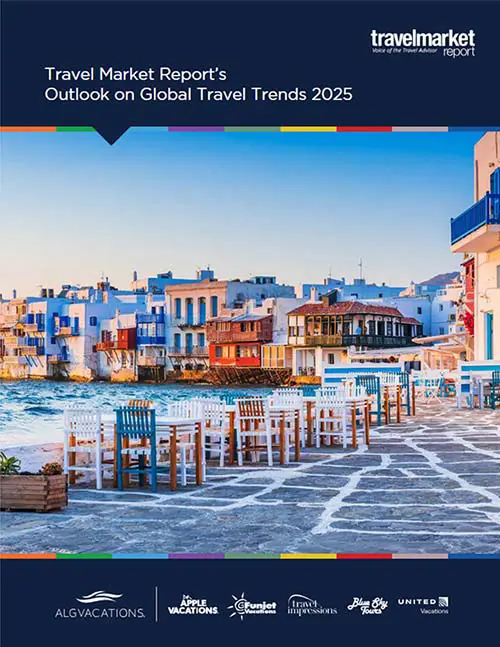What Is the State of the Tour Industry?
by Daniel McCarthy
USTOA's Terry Dale on stage on Wednesday.
This week, members of the United States Tour Operators Association (USTOA) gathered in Austin, Texas for the association’s annual marketplace, to continue to tell the story of the tour industry.
This year’s event marked the 50th year of USTOA, an association that was created in 1972 in California in order to build the industry and bring integrity to tourism. The group grew quickly, adapting to continuous change over time while keeping that mission of integrity in tourism at its heart.
As part of the annual marketplace, USTOA Board Members, which include ALG Vacations’ Scott Wiseman, CIE Tours’ Elizabeth Crabill, Collette’s Jeff Roy, TTC’s Madhvi Buch, and Holland America’s Charlie Ball, presented the group’s latest research—the USTOA 2022 Economic Impact Study.
The survey, the first one undertaken since the pandemic, and the fifth one overall, surveyed 92% of USTOA corporate members to find out what is driving the tour industry now, and what could be on the horizon. Here’s what they said:
Recapping 2022
Even though the industry has ridden a wave of recovery since the world began reopening, there’s still room to go to hit the 2019 marks for USTOA and the tour industry.
The 2022 economic impact of travel packages sold, which came in at almost $16 billion, was down 13.4% compared to 2019, as was the number of individual travelers (-20.5%) and the total number of packages sold (-22.6%).
Still, despite those numbers, there was optimism from the USTOA board, including ALG Vacations’ Scott Wiseman who said that revenue sold being 87% of pre-pandemic is a “good number” considering the impact the Omicron variant had on the industry in the beginning of the year, and the anticipated absence of any COVID drag in 2023.
For travel advisors, the good news came that, even though the total number of packages sold went down, the percentage of them sold by travel agencies is off by less than 1% compared to 2019 (58.4%).
There’s also good news in pricing—prices are up in some areas as high as 20% in some areas, but it doesn’t seem to be stopping consumers just yet.
Top Destinations
Iceland remains on top of the “Off-the-beaten-path” countries ranking by USTOA members, followed by Egypt, which is a new entry, Croatia, Colombia, and Norway, another new entry.
For “Hot destinations,” members say there is still a lean toward the old favorites—that list was led by Italy, which was followed by Greece, France, the U.K., and Iceland. The only big change here was Iceland dropping from 2 to 5 in the survey rankings.
Looking Forward to ’23
The majority of USTOA members are very positive for 2023.
According to the survey, 55% of all members say they expect a more than 10% increase in sales volume for 2023 and another 27% said they anticipate a sales growth volume of somewhere between 7% and 9%. Only 4% of all members said they anticipate that sales volume will either be unchanged or will decrease.
Also according to the survey, 55% of members said they anticipate a 10% or more growth in passengers and another 25% said they expect a passenger growth somewhere between 7% and 9%. Just 4% said they expect a decrease in passengers.
All-in-all, tour operators are bullish on a full recovery and beyond next year, but there are still some worries out there for members.
The top risk, according is the continuing rise in the cost of living—67% of all members said that cost of living increases is something they are either extremely or very concerned about.
That was higher than the 49% who said the same about pandemics and other health issues, the 59% who said the same about staffing issues, and the 59% who said the same about global financial insecurity.
Asked about a possible looming recession or growing consumer weakness next year, USTOA Board Members said that, despite headlines from outside of the industry and increasing prices, they are not yet seeing consumers pull back from travel spending.
“It’s not showing up in the booking patterns, which is a good thing,” ALG Vacations’ Scott Wiseman said. “The pent-up demand is still very real, and it seems like you’re going to see people still want to splurge on travel.”
“There’s still a large pot of savings that people had coming through COVID, while people dipped into their savings, there is still a surplus, in general, that is out there,” he added.
Wiseman said that tour operators are generally preparing for what could happen, but the trend among consumers is that their priority is still to travel and they are willing to spend to do so.
Collette’s Jeff Roy added that booking patterns right now “could be sustainable if we get a slight recession” as the post-COVID revenge travel trend is very much alive.
“We see customers now that are doing major trips twice in a year and that would have been two trips over three years before,” he said.
























